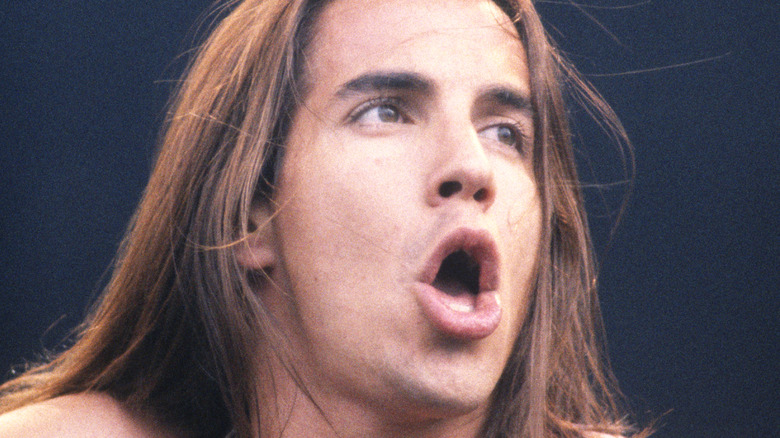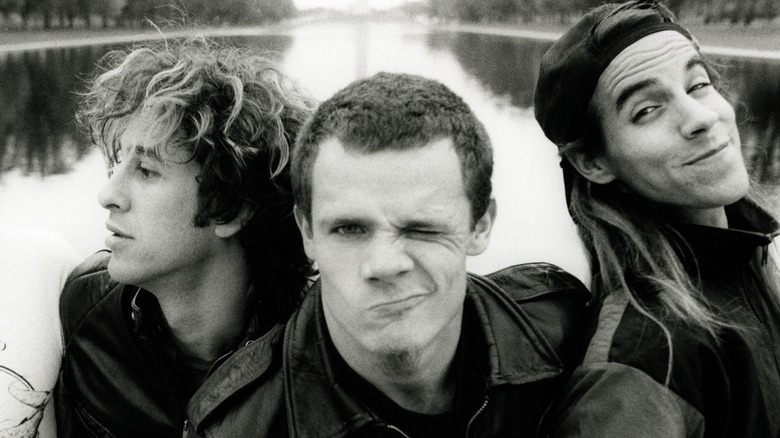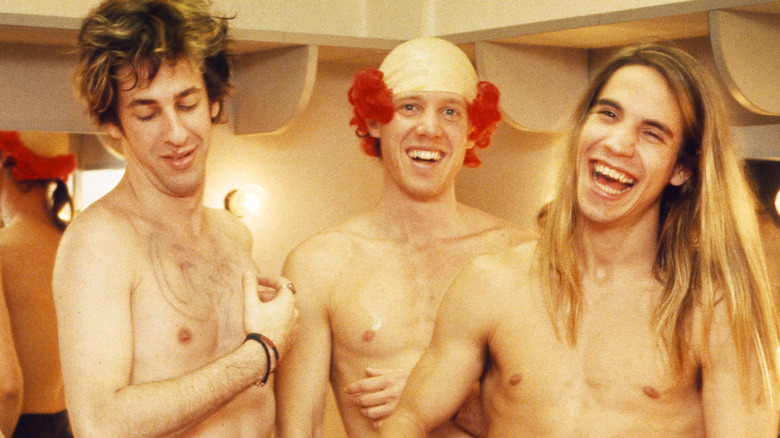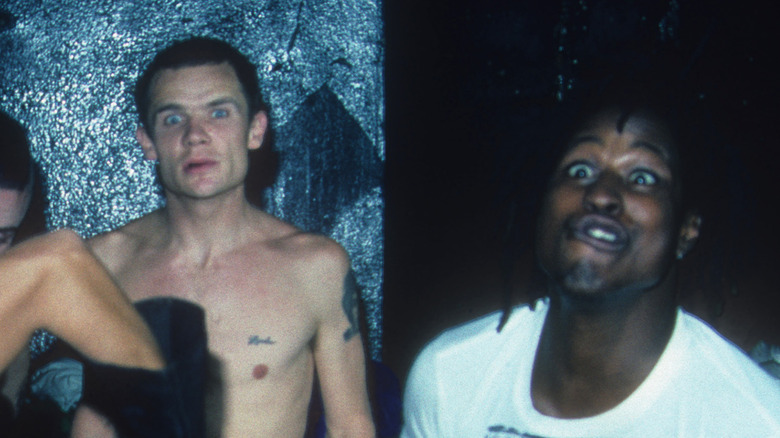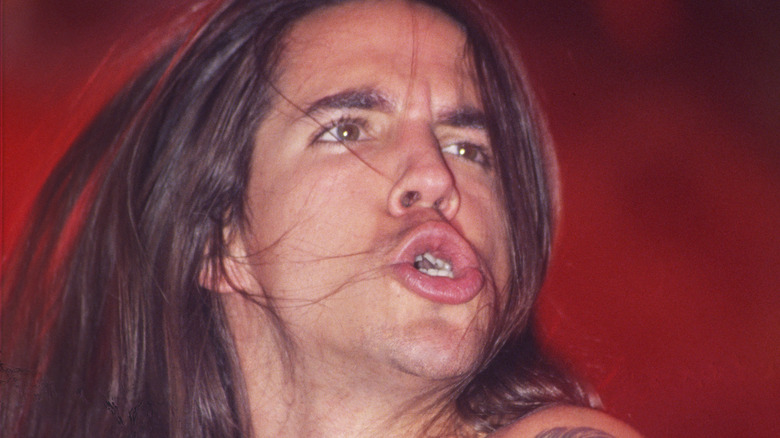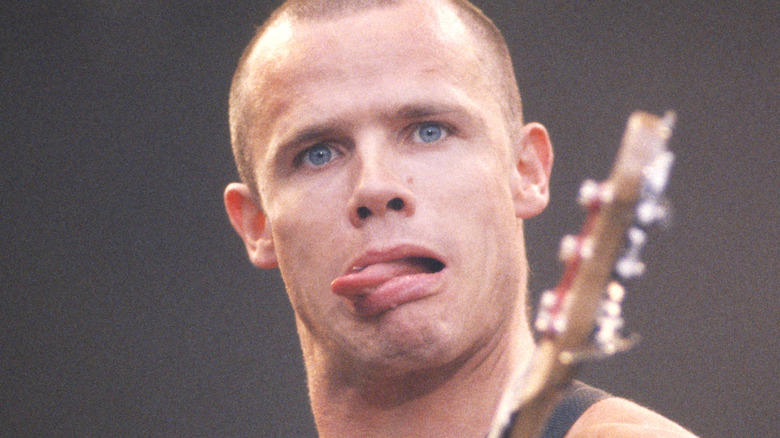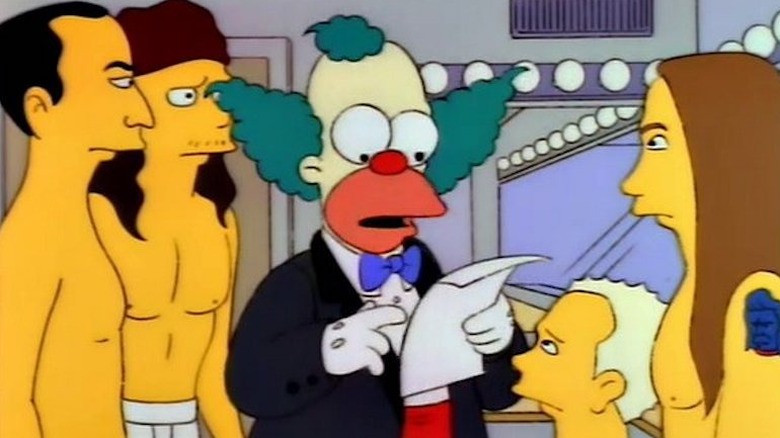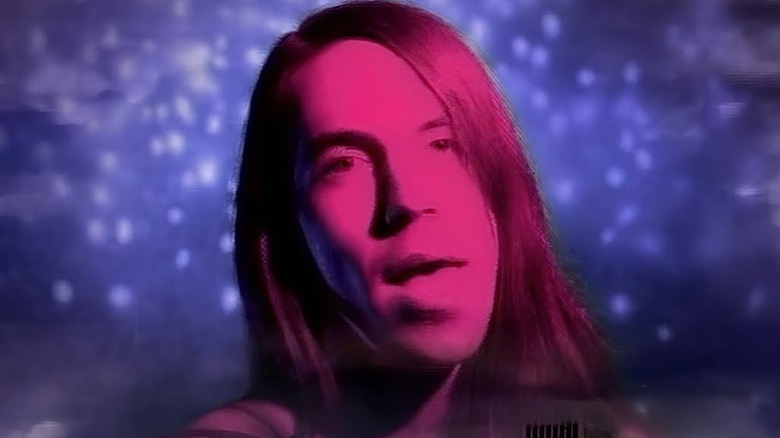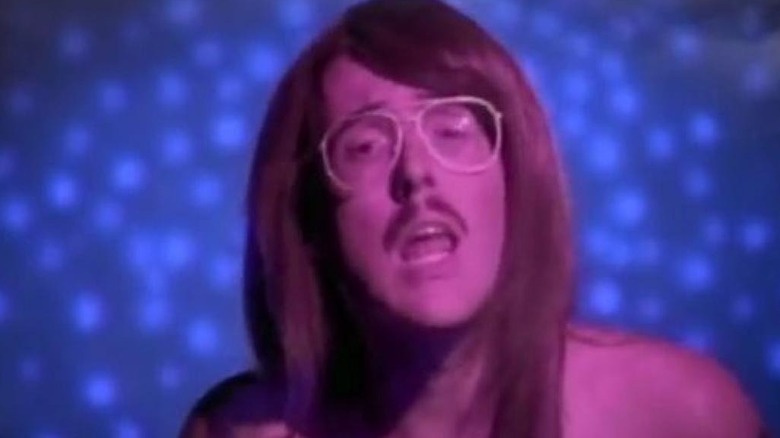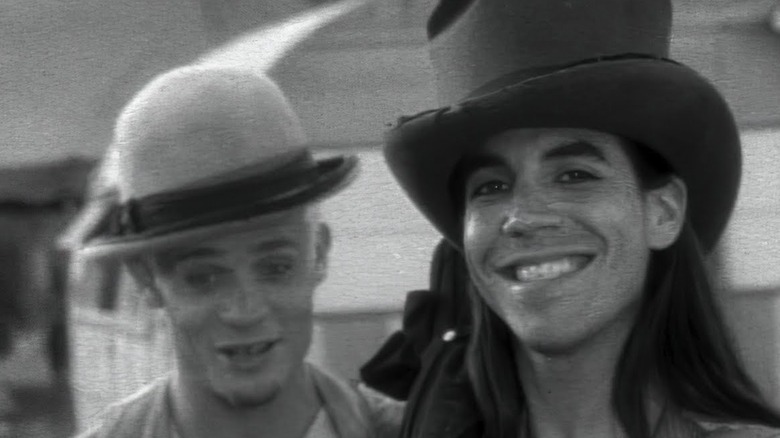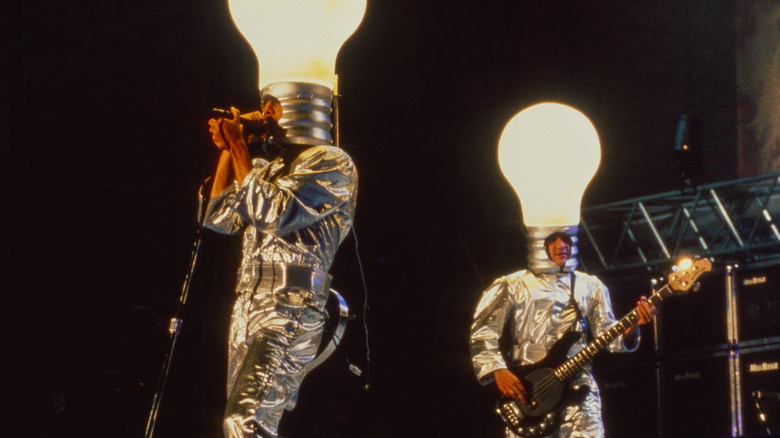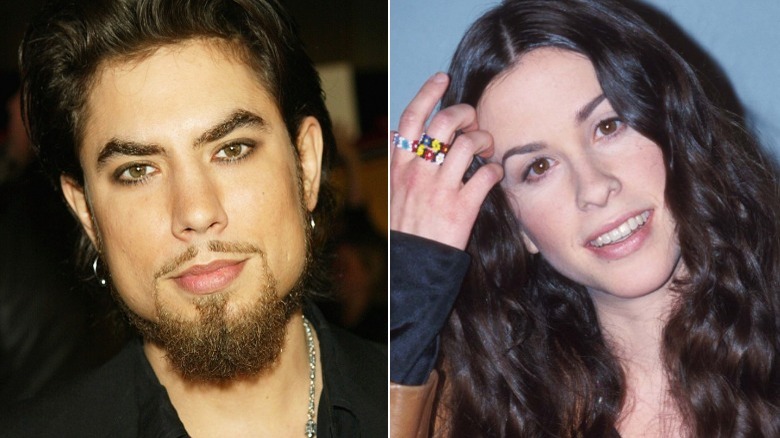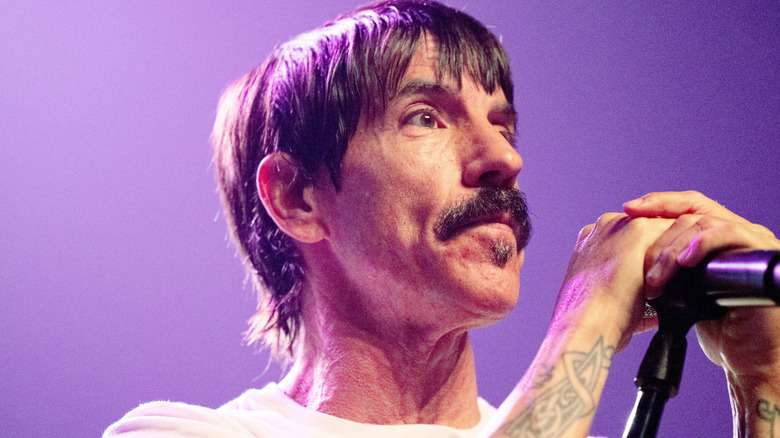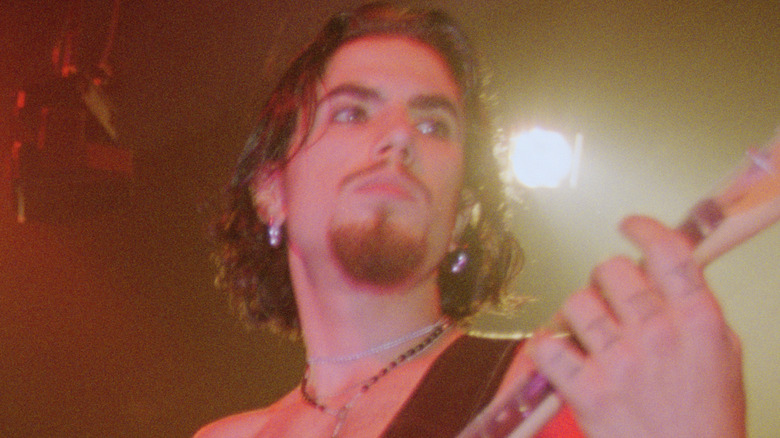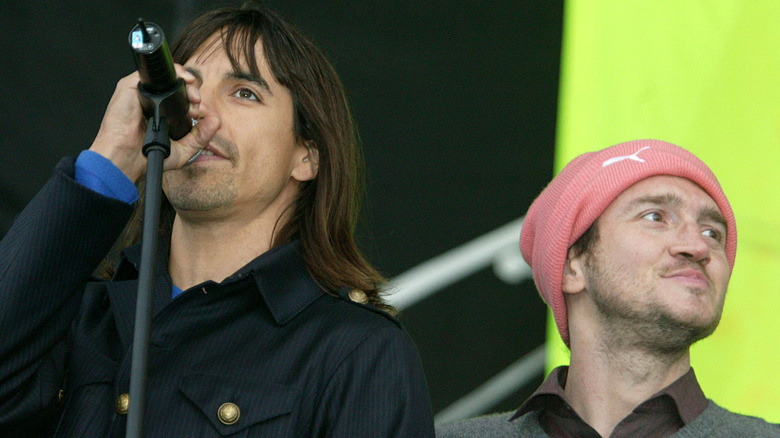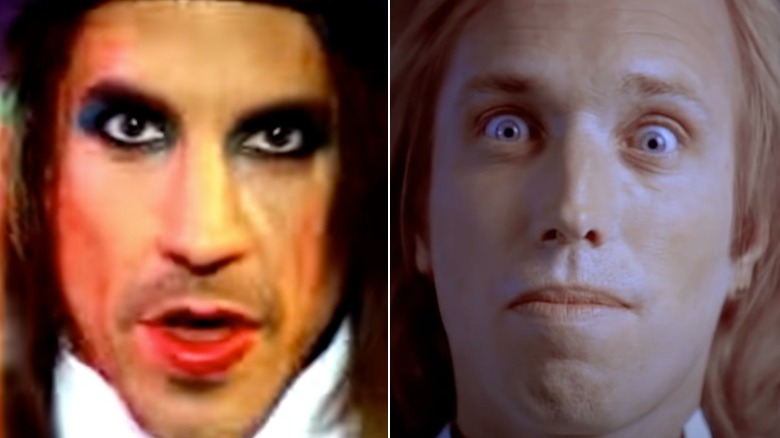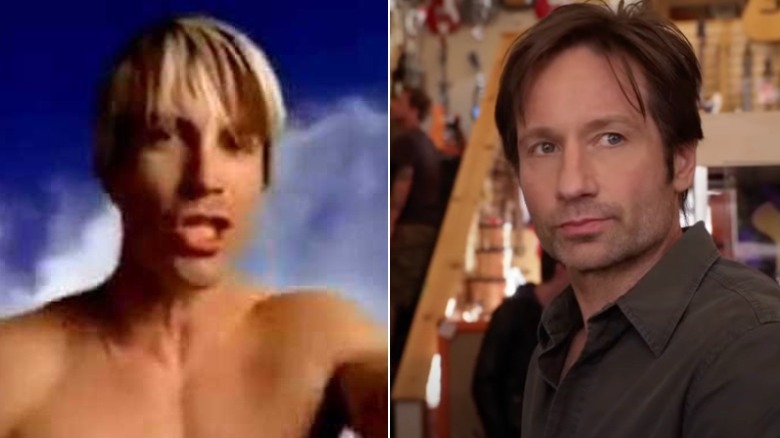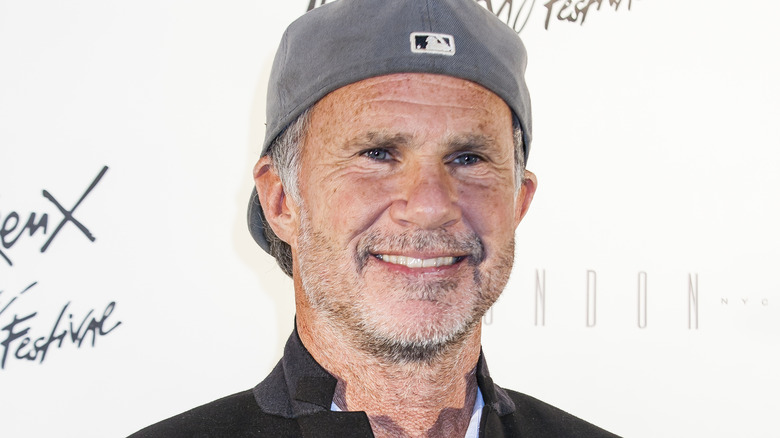The Untold Truth Of Red Hot Chili Peppers
As one of the most dominant and beloved American rock bands of the 1990s and beyond, there are certain things most everybody knows about the Red Hot Chili Peppers — like how they're proudly from California, or that their songs celebrate debauchery (when they aren't about the crippling sting of addiction). And yet, unlike most bands who burn brightly and fade away, the Chili Peppers continued to grind out rock hits, adapting their sound and keeping themselves at the top of radio playlists and the Billboard charts year after year, decade after decade.
But that's just the Red Hot Chili Peppers, the improbably successful, wild and zany outfit of shirtless party monsters who mix funk, punk, and rap into something that probably shouldn't work as well as it does. And on the other hand, they've generated some of the most affecting ballads of their generation. What we've got, we've got the untold truth and we want to put it into your brain. We're giving it away, by the way, so take a trip to the otherside, the coffee shop, or around the world and learn lots about the Red Hot Chili Peppers.
Their majestic, mayhem-filled origins
Before the Red Hot Chili Peppers were a four-member band influenced nearly equally by funk music and punk rock, they had a different set of members from when they'd find fame and fortune, as well as a name even sillier and longer. According to Flea's memoir "Acid for the Children," the original lineup in 1983 consisted of Jack Irons on drums, Hillel Slovak on guitar, Flea (Michael Balzary) on bass, and Anthony Kiedis on lead vocals, combining singing with rap and spoken word and also contributing the group's first moniker: Tony Flow and the Majestic Masters of Mayhem. One of the first pieces the band took on was a song based on a loosely structured poem Kiedis wrote called "Out in LA" — so even from the beginning, the Red Hot Chili Peppers were grappling with the meaning of California.
Flea is a major fan and student of jazz, and according to Ohio State University, that may have influenced the band's permanent name. The first "Red Hot Chili Peppers" was the nickname of jazz great Louis Armstrong's 1920s-era quintet.
Socking it to the Red Hot Chili Peppers
A lot of huge rock bands have a signature, memorable look, whether it's the early Beatles in matching suits, the later Beatles in their pastel Sgt. Pepper military uniforms, or the Red Hot Chili Peppers for their lack of clothing — the band famously takes the stage and appears in videos and on their albums with their shirts off seemingly more often than not. That's something of a compromise the band made with the world when it entered the mainstream, because in its early days, the Chili Peppers often performed shows completely or comically nearly naked.
According to Far Out, the band booked one of its first ever shows at the Kit Kat Club, a strip club in Hollywood, California, in 1983. As a nod to the clothing-optional nature of the establishment, the Chili Peppers took the stage with only their instruments and white tube socks covering their male organs. Singer Anthony Kiedis's idea, the sock bit became the band's calling card, and other clubs in the Los Angeles area asked the Chili Peppers to perform, provided they dress (or undress) in a similar fashion. They'd still break out the tube sock routine on occasion throughout the '90s for arena and stadium shows, retiring the gimmick in 2000 as the band's members approached middle age. However, bassist Flea hit the stage for the Woodstock '99 festival without the sock, performing completely naked, according to MTV News.
Just one band was never enough
The Red Hot Chili Peppers isn't the only creative, musical outlet for its members, past and present. Ever since the band's formation in the early 1980s, the musicians in the Chili Peppers split their time with other projects.
According to Guitar World, before any of them would be affiliated with the Red Hot Chili Peppers, future members Flea (bass), Hillel Slovak (guitar), and Jack Irons (drums) formed a band as classmates at Fairfax High School in Southern California. First named Chain Reaction, they changed it to Anthem, and then to What Is This? Those three got together with Anthony Kiedis to form the band that would become the Chili Peppers, although Slovak and Irons considered What is This? to be their main band (releasing a single, self-titled album on MCA Records), until they eventually left to connect with Kiedis and Flea full time, per Diffuser.
After Slovak's death in 1988, Irons quit the Chili Peppers in grief, prompting Kiedis and Flea, according to "Scar Tissue," to replace the drummer with D.H. Peligro, with whom they'd played in a side band called Three Little Butt Hairs.
Anthony Kiedis was fired from his own band
According to Diffuser, the Red Hot Chili Peppers have used many different drummers and lots of guitarists over its nearly 40-year history. The only continuous members of the group are bassist Flea and frontman Anthony Kiedis — and even he quietly, unofficially, acrimoniously, dropped out of the band for a little while in the 1980s. While recording the 1987 album "The Uplift Mofo Party Plan," producer Michael Beinhorn told Produce Like a Pro (via Alternative Nation) that he fired an unreliable and inconsiderate Kiedis after going "through hell" during its creation. "I actually kicked him out of the band, which is not my position at all, but I was like, 'You know, you're disrespecting the rest of your band. This can't go on. This project's going to fall apart. Get out.'"
Kiedis took the firing as a sabbatical, heading to Michigan to "clean up," as Beinhorn said. During his 6-week absence, the remaining Red Hot Chili Peppers auditioned several replacement singers, none of which were up to their standard. Kiedis asked if he could return, and Beinhorn allowed him to do so.
The door is always open for John Frusciante
The fourth guitarist in the Red Hot Chili Peppers overall, according to Ultimate Classic Rock, John Frusciante joined the band in 1988 and played on the albums "Mother's Milk" and "Blood Sugar Sex Magik." But after the latter brought the Chili Peppers mega-fame, Frusciante bristled. "John would say, 'We're too popular. I don't need to be at this level of success,'" singer Anthony Kiedis recalled in "Scar Tissue."
That led to palpable tension in the band and, according to Kiedis, he and Frusciante stopped speaking to each other. Then the guitarist seemingly tanked the group's February 1992 performance on "Saturday Night Live." "I had no idea what song he was playing or what key he was in. He looked like he was in a different world," Kiedis wrote (via Live For Live Music). "We were on live TV in front of millions of people, and it was torture."
Frusciante left the Chili Peppers later that year, per Rolling Stone, only to return in 1998 when things didn't work out with guitarist Dave Navarro. Frusciante played on the band's massively successful millennium-adjacent records like "Californication," "By the Way," and "Stadium Arcadium," before leaving for the second time in 2009, according to Rolling Stone. Then he returned once more, replacing his one-time replacement, Josh Klinghoffer, in 2019, according to Guitar World, just in time to play on the group's 2022 release "Unlimited Love" and embark on a world tour.
A shocking Spring Break with the Red Hot Chili Peppers
Rising stars of the Los Angeles rock scene and notorious for being a wild and dynamic live act by the late 1980s, MTV invited the Red Hot Chili Peppers to show off to a national television audience by performing at a Spring Break event in Daytona Beach, Florida, in 1990. According to the Orlando Sentinel, the Chili Peppers got so amped up they were driven to break the law.
During a taping of the dance show "Club MTV," the band lip-synced to its song "Knock Me Down." At some point, bassist Flea started to smash his bass against Chad Smith's drums. Before long the two had thrown stuff all over the stage, and then headed into the audience of swimsuit-clad beachgoers where, according to a police report, Flea grabbed a 20-year-old Virginia woman, picked her up, and threw her over his shoulders. Smith then came over, tried to pull down the woman's bathing suit, and slapped her rear end. After she fell into the sand, Flea allegedly climbed atop the woman and requested she perform a certain act on him.
MTV acted quickly and ejected the entire band from its beachside facilities. Volusia County Beach Rangers later arrested Flea and Smith, and, acting at the behest of their victim, charged both musicians. Flea faced misdemeanor counts of battery, disorderly conduct, and solicitation to commit a lascivious act; Smith was charged with battery. Both men posted bail and were released.
Arik Marshall's quick time in the band proved fruitful
A lot of men have served in the role of lead guitarist for the Red Hot Chili Peppers, according to Diffuser. Following the death of original guitarist Hillel Slovak, the brief tenures of Jack Sherman and DeWayne McKnight, and just after the end of John Frusciante's first stint with the group, Los Angeles-based session musician and Marshall Law member Arik Marshall became a Chili Pepper, according to Anthony Kiedis's "Scar Tissue." His time with the band was brief, but also eventful. Marshall came on board in 1992, while the band was touring behind and promoting "Blood Sugar Sex Magik," which, thanks to hits like "Give It Away" and "Under the Bridge," was one of the band's most commercially successful and cultural visible eras.
Marshall dutifully performed with the band and made public appearances, but he never actually recorded anything for a Chili Peppers album. He did, however, pretend to play Frusciante's guitar parts in two videos, for the singles "Breaking the Girl" and "If You Have to Ask," and was immortalized in animated form when the Red Hot Chili Peppers appeared and played "Give It Away" on "Krusty Gets Kancelled," a 1993 episode of "The Simpsons."
'Under the Bridge' wasn't supposed to be a Red Hot Chili Peppers song
In 1992, the soaring "Under the Bridge," an uncharacteristic ballad for the funky Red Hot Chili Peppers, went to #2 on the Billboard pop chart, the group's biggest hit ever. And according to the guy who wrote it, "Under the Bridge" wasn't supposed to be a song in the first place. A haunted reflection of his time in the throes of heroin addiction, Chili Peppers lead singer Anthony Kiedis says the lyrics popped into his head, as he began "free-styling some poetry in my car and putting the words to a melody and sang all the way down the freeway," he said in his memoir "Scar Tissue" (via "The Poetry of Pop"). Once home, he scribbled the lines down in a notebook "in song structure, even though it was meant to be a poem to deal with my own anguish."
Flash forward to production on the Red Hot Chili Peppers' "Blood Sugar Sex Magik" album in the early '90s. The group hired producer Rick Rubin, who went to Kiedis's house to see the singer's writings. While scanning a notebook, he discovered "Under the Bridge." "And I was like, 'This looks really good. What is this?' And Anthony's like, 'Well, it's a poem, and a song, but it's not a Chili Peppers song.' And I was like, 'Why not?'" Rubin convinced Kiedis to see past his usual funk-rap lyrical approach and turn the piece into a full-on song.
Flea did not like Weird Al's Red Hot Chili Peppers parody
The Red Hot Chili Peppers were absolutely massive in the early 1990s. The frenetic and funky "Give It Away" hit #1 on Billboard's alternative rock chart and the striking addiction ballad "Under the Bridge" made it to #2 on the all-genre Hot 100. That kind of popularity, coupled with the band's memorable music videos and wild, semi-clothed public personas, made parody almost inevitable, and "Weird Al" Yankovic, the master of musical satire, obliged. In 1993, he created "Bedrock Anthem," a parody that combined the intro of "Under the Bridge" with the whole of "Give it Away," but with lyrics a boastful, first-person rundown of a day in the life of cartoon character Fred Flintstone. (For example, "give it away, give it away, give it away now" became "Yabba-dabba-yabba-dabba-dabba-doo now.")
Not a fan of "Bedrock Anthem": Red Hot Chili Peppers bassist Flea. In the band's episode of VH1's "Behind the Music," he took a moment to thoroughly take down Yankovic's parody of his songs. "I didn't think it was very good," Flea said, "It wasn't that great. Yabba-dabba-doo?" While he tempered his remarks by mentioning that he usually likes Yankovic's work, "Everyone's hit and miss."
The Red Hot Chili Peppers refuse to give up on old songs
The Red Hot Chili Peppers are one of the longest-lasting and most prolific American rock bands of all time. Since forming about 40 years ago, they've churned out 12 studio albums and several dozen EPs and singles. And yet, many prominent singles from the band followed a very strange and nontraditional release pattern. After notching four hits from its multi-platinum bestseller "Blood Sugar Sex Magik" in 1991 and 1992, the Chili Peppers issued "Behind the Sun." It reached #7 on Billboard's alternative rock chart, despite being a 5-year-old song, originally appearing on the 1987 LP "The Uplift Mofo Party Plan" and featuring the sitar playing of late Pepper Hillel Slovak, who died in 1988. It was meant to promote the 1992 best-of collection "What Hits!?"
In the summer of 1993, the Red Hot Chili Peppers topped the Billboard alternative chart with "Soul to Squeeze," a cut from the soundtrack of "Coneheads." That same song, recorded for "Blood Sugar Sex Magik" but left off the final mix, had previously been used as the B-side for the album's two biggest hits, "Under the Bridge" and "Give It Away."
Dave Navarro had to endure a wacky stage stunt
After some brief dalliances with Arik Marshall and Jesse Tobias, according to Diffuser, the Red Hot Chili Peppers found a more permanent lead guitarist in Dave Navarro, who, with his years in the popular Jane's Addiction under his belt, turned the Chili Peppers into a supergroup. Navarro officially joined in 1994, per MTV News, and his very first performance with the group was a massive and important one: a set at the Woodstock '94 festival in upstate New York.
...And he had to play while wearing a silver jumpsuit and gigantic, working light bulb on his head, a concept devised for the band by frontman Anthony Kiedis. "He drew it on a napkin or on a piece of paper, and we handed it to these guys, and none of saw the actual prop until we were 10 minutes away from going onstage, in front of a festival audience, cameras, satellite productions," Navarro told SiriusXM Volume (via Yahoo!) of the bulbs that weighed about 60 pounds and didn't stay put.
Months later, the band played "The Late Show with David Letterman," which taped in a studio kept chilly, per the host's liking. The band dressed appropriately, in hooded, fur-lined coats, along with mirrored shades. "But we didn't realize at the time that we looked exactly like the police sketch" of the Unabomber, highly sought after by federal authorities in the mid-1990s.
The unlikely Alanis Morissette-Red Hot Chili Peppers crossover
The year 1995 was a big one for the Red Hot Chili Peppers. That's when the band released "One Hot Minute," its first full-length album in four years, debuting a darker, moodier sound thanks in part to the addition of new guitarist Dave Navarro, late of alternative rock pioneers Jane's Addiction. But arguably nobody was bigger in rock in 1995 than Alanis Morissette, the Canadian former teen pop star who released the raw, confessional "Jagged Little Pill," which sold 16 million copies (via the RIAA) and generated six hit singles.
There are some surprising overlaps between the Red Hot Chili Peppers and Morissette, who don't really sound that much alike. Prior to hiring Navarro, the Chili Peppers employed the services of Jesse Tobias for one month before dismissing him, according to Rolling Stone. Nevertheless, Tobias found a gig as a guitarist for Morissette's blockbuster tour in support of "Jagged Little Pill." That album's breakout single, and Morissette's signature song: "You Oughta Know." It featured guitar and bass work from, respectively, Navarro and Flea of the Red Hot Chili Peppers.
The Red Hot Chili Peppers' year of nothing
The Red Hot Chili Peppers were very active throughout the 1990s, recording soundtrack cuts and other standalone singles when they weren't making albums, or touring to promote those albums. About the only year in the whole decade when the Chili Peppers did very little was 1997, a period so disastrous and fallow it almost undid the band entirely.
According to Exclaim, bassist Flea nicknamed it the "Year of Nothing," on account of how the Chili Peppers played exactly one concert in 1997, or actually, not even that much. The band's set at the Fuji Rock Festival, an outdoor multi-act show staged in the shadow of Mt. Fuji in Japan, was cut short upon the arrival of Typhoon Rosie, according to MTV News. They attempted to keep playing, and keep fans' spirits up, with a cover of the Spice Girls' "Wannabe," but few could hear the music over the sounds of extreme weather, and they literally ran off stage for cover before the roof collapsed on top of them.
Other shows the band was scheduled to play in the coming months were canceled, too, because singer Anthony Kiedis was in no state to perform. In 1997, he got into a motorcycle accident and broke his wrist and arm, requiring surgery and nine months of convalescence. The painkillers he was prescribed sent him relapsing, once again using the heroin he'd kicked before, according to Rolling Stone.
Why Dave Navarro left the band
After four years and just one LP, "One Hot Minute," Dave Navarro parted ways with the Red Hot Chili Peppers in April 1998, according to MTV News. At the time, Navarro said there was no animosity behind his departure, and that he wanted to spend more time on Spread, a band he formed with Chili Peppers drummer Chad Smith. But his actual reasons for leaving were far more complex.
In 2018, Navarro said on his "Dark Matter" podcast (via Alternative Nation) that he'd relapsed in his sobriety from drugs while on a Jane's Addiction reunion tour in 1997, which he believes rattled Flea, as the Chili Peppers had "already lost" founding guitarist Hillel Slovak to a heroin overdose. When he reported to a band rehearsal, Navarro says he "honestly couldn't play a f****** note" he was so drugged. "I literally tripped into stacks of speakers and storage gear and whatever." Around that time, early '90s-era Chili Peppers guitarist John Frusciante made overtures to get back into the band, and as he was sober and Navarro was not, the others chose Frusciante.
There's a lost Red Hot Chili Peppers album
As of 2022, the Red Hot Chili Peppers have released 12 studio albums — but they've recorded 13 full-length LPs. In 2003, according to Ultimate Classic Rock, the band booked some time to record a couple of songs to be used as bonus, new cuts on a greatest hits album. Instead, they recorded 16 songs, and used just two of them ("Fortune Faded" and "Save the Population") for their intended purpose, while versions of others appeared on later releases. Still, there's more than enough left for an entire album that captures the Red Hot Chili Peppers at a moment in time in the mid-2000s. "Twelve of them were probably good," drummer Chad Smith told Modern Drummer (via JEffects) in 2011). "We were going to come back and write some more songs, and I was like, 'Let's just write another 10, take maybe seven out of that, add it to the others we'd previously done, and we'll have a record.'"
Guitarist John Frusciante nixed the idea. Nine months after recording that first batch of abandoned songs, he'd moved on to a different kind of playing style and didn't want to move backwards creatively. "So there's an album that we did that I don't know if anyone's ever going to hear," Smith explained.
'Dani California' treaded familiar ground in more than one way
After a years-long hiatus, the Red Hot Chili Peppers stormed back in 2006 with the double album "Stadium Arcadium," launched by the Top 10 hit "Dani California." Inspired by a "funky groove" generated by his bandmates, frontman Anthony Kiedis started to compose the lyrics to a song about a young woman named Dani, and soon figured out that he was writing about the same subject he'd written about previously. "I realized that Dani in 'By the Way' was about the girl in 'Californication,' the 'teenage bride with the baby inside.' And so it sort of revealed itself to me," Kiedis said in a band interview, with "Dani California" completing the trilogy of hit songs about the same ill-fated fictional character, a woman who moves from the South and heads out west to a life of disappointment and stress.
According to UPI, the content of "Dani California" was familiar to people besides Kiedis — it shared a chord progression, tempo, melody, and lyrics about an uneasy Southern woman with "Mary Jane's Last Dance," a 1993 hit by Tom Petty and the Heartbreakers. An informant close to the situation told the New York Post that Petty was looking into litigating the matter, but he ultimately decided against it. "I seriously doubt that there is any negative intent there," Petty told Rolling Stone. "It doesn't bother me."
The 'Californication' band sued the network behind the 'Californication' TV show
While the Red Hot Chili Peppers avoided a potentially expensive and embarrassing legal battle with Tom Petty over "Dani California," they also filed a lawsuit against the producers of a TV show, alleging several intellectual property crimes. In August 2007, Showtime debuted the dramedy "Californication," starring David Duchovny, a hard-drinking, serial adulterer and novelist living in Los Angeles. The title is a portmanteau of "California" and "fornication," and it's also the name of a 1999 Red Hot Chili Peppers album that sold more than 7 million copies, according to the RIAA.
In November 2007, per MTV News, the Chili Peppers sued Showtime Networks, alleging dilution of the value of the word "Californication" and unfair competition, as the name is "inherently distinctive, famous, and immediately associated in the mind of the consumer" with the rock band who came up with it and used it first. "For some TV show to come along and steal our identity is not right," singer Anthony Kiedis said in a statement, with the band's attorney, Justin Ehrlich, adding that the group was "particularly offended that Showtime used its material without permission." "Californication" the series further cribbed from the Chili Peppers with the inclusion of a character named Dani California.
It's unclear what happened with the suit, but since the show didn't have to change its name, it may have been settled out of court.
The Red Hot Chili Peppers are banned in China
The Red Hot Chili Peppers are popular all over the world. They've been awarded platinum sales certifications in Australia, France, and Canada, among other nations, but one market where the Red Hot Chili Peppers aren't likely to sell millions of records anytime soon is to the billion-plus residents of China. According to Far Out, one of several editions of the Tibetan Freedom Concert took place at RFK Stadium in Washington, D.C. in 1998. Along with billed, announced performers like Radiohead, Sonic Youth, R.E.M., and the Beastie Boys, the Red Hot Chili Peppers were a surprise late addition, playing with former guitarist John Frusciante for the first time in six years. The reason for the show: to raise awareness of (with the goal of ultimately liberating) Tibet, a small Asian country under the control of communist China, according to Spin. It's also the homeland of the Dalai Lama, head monk of the Tibetan sect of Buddhism and an enemy of the Chinese state, per CNN.
In 2018, Red Hot Chili Peppers drummer Chad Smith revealed to Sirius XM radio host Duff McKagan that his band was summarily banned from the nation of China. "Because we've got Dalai Lama connections," Smith explained, referring to his band's participation in the Tibetan Freedom Concert. "They don't like that." McKagan and Smith also theorized that the band's semi-or-fully-nude stage presence and profanity-laced lyrics didn't do them any favors with the Chinese government.
